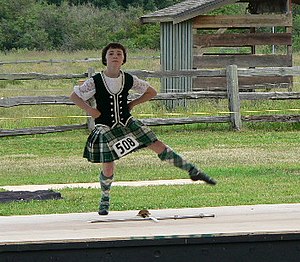| Revision as of 23:00, 22 November 2006 edit202.37.227.112 (talk) →References← Previous edit | Revision as of 23:01, 22 November 2006 edit undo202.37.227.112 (talk) →External linksNext edit → | ||
| Line 18: | Line 18: | ||
| ==External links== | ==External links== | ||
| * | * | ||
| * | |||
| * | |||
| * | |||
| * | |||
| * | |||
| * | |||
| * | |||
| * | |||
| * | |||
| * | |||
| * | |||
| * | |||
| * | |||
| * | |||
| * | |||
| * | |||
| * | |||
| * | |||
| * | |||
| ==References== | ==References== | ||
Revision as of 23:01, 22 November 2006

The term Highland dancing is used today to refer to a style of athletic solo dancing which evolved into its current form during the nineteenth and twentieth centuries in the context of competitions at public events (namely, Highland games), where it is typically performed to the accompaniment of bagpipe music.
The term is somewhat misleading, however, in that it is only one form of dancing to have been done in the Scottish Highlands and, in addition, it has been subject to many influences from outside the Scottish Highlands. For example, it has been heavily influenced by the urban aesthetics of the patrons and judges of dance competitions since the nineteenth century.